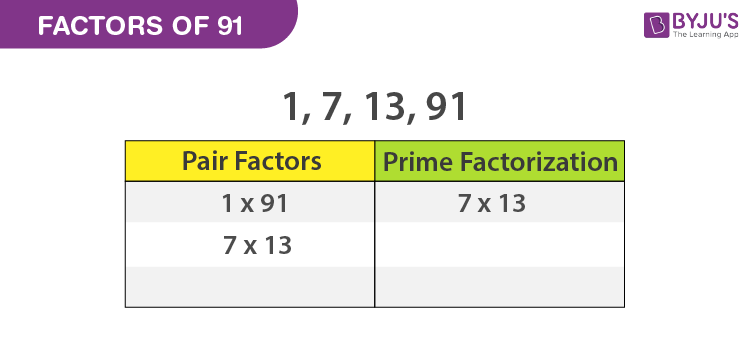Factors of 91
Factors of 91 are the numbers that divide the original number completely or evenly. The two numbers that result in 91, after multiplication, are the pair factors of 91.
The factors of real number, 91, are 1, 7 13, and 91. They are all integers and not fractions. To find the factors of a number, 91, we can use the factorization method.

In the factorization method, first take the numbers, 1 and 91 as factors and continue with finding the other pair of multiples of 91 which gives the results as an original number. To understand this method in a better way, read the article below to find the factors of 91 in pairs. Also, the prime factors of 91 with the help of the division method is discussed here
Pair Factors of 91
To find the pair factors, multiply the two numbers in a pair to get the original number as 91, such numbers are as follows
| Pair Factors |
| 1 × 91 = 91 ⇒ (1, 91) 7 × 13 = 91 ⇒ (7, 13) |
Therefore, the pair factors are (1,91) and (7, 13).
Similarly, we can write negative pair factors. If we multiply two negative factors, then we get the original number, which is positive.
(-1) × (-91) = 91
(-7) × (-13) = 91
Therefore, the negative pair factors are (-1, -91) and (-7, -13).
How to calculate the Factors of 91?
Learn the following steps to calculate the factors of a number 91.
-
- First, write the number 91
- Find the two numbers, which give the result as 91 under the multiplication, say 7 and 13, such as 7 × 13 = 91.
- We know that 7 and 13 are prime numbers that each number has only two factors, i.e., 1 and the number itself. So, it cannot be further factorized.
7 = 1 × 7
13 = 1 x 13
- Therefore, the factorization of 91 is written as 91 = 7 x 13 x 1
- Finally, write down all the unique numbers which we can obtain from 7 x 13 x 1
| Factors of 91 |
| 1, 7, 13, and 91 |
Prime Factors of 91
The number 91 is a composite and it should have prime factors. Now let us know how to calculate the prime factors.
-
- The first step is to divide the number 91 with the smallest prime factor, say 7.
91 ÷ 7 = 13
-
- When you divide 13 by 7, you will get a fraction, that cannot be a factor of a number. So proceed with the next prime factor, say 13
13 ÷ 13 = 1
Finally, we received the number 1 at the end of the division process. So that we cannot proceed further. So, the prime factors are written as 7 x 13, where 7 and 13 are the prime numbers.
Solved Examples
Q.1: If there are 13 members in a hall and each of them has 7 books, then how many total books are there?
Solution: Given,
Number of members = 13
Number of books each member has = 7
Total number of books = 13 x 7 = 91
Q.2: What are the common factors of 91 and 126?
Solution: We know that the factors of 91 are 1, 7, 13, 91.
Factors of 126 = 1, 2, 3, 6, 7, 9, 14, 18, 21, 42, 63, 126
Therefore, 1 and 7 are the only common factors of 91 and 126.
Register with BYJU’S – The Learning App to learn the factors of 91 and also the factors and prime factors of other numbers by factorization and division method.